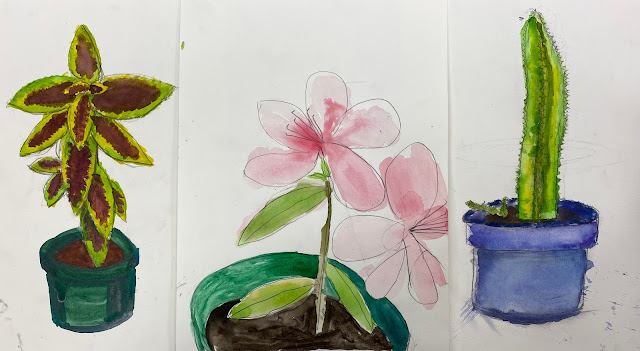I like to think of Yayoi Kusama as the Betty White of the art world, because it's not every day that you find a woman in her nineties attract such a huge, young, fanbase on social media. She's the Princess of Polka Dots and her infinity mirror rooms, and polka dotted pumpkins have been drawing large crowds: 6 million last year alone. I couldn't get tickets to see her work when she was showing in Georgia. I like to teach my students about artists who have overcome great difficulties, such as mental health issues (the polka dot and net motifs come from Kusama's hallucinations), and non-supportive families. My students have huge challenges in their lives that I hope will strengthen them rather than defeat them. Art is a tool to navigate or face problems. It is for Kusama. I also love that she uses very high contrasting colors, like red and white or black and yellow, because it's easier for my visually impaired students to differentiate between shapes. For students with no vision, they sketched their ideas on a Tactiledoodle, translated the sketch onto large paper with Wiki Stix, and then I traced their drawing in hot glue so they could take up the Wiki Stix and paint their work by touch. So we studied an artist, we studied contrast, we studied pattern, and then we made our patterned paintings.
Friday, January 28, 2022
Maria Sybilla Marien Lesson Plan
I thought it might be fun to explore the same subject in different styles and media while studying a different artist. So we transitioned from Georgia O'Keefe abstracted and large scale flower images to Maria Sybilla Merian botanical water color paintings. O'Keefe was an American who lived 100 years ago, while Merian was a German who lived in the 1600s. She was an artist and naturalist who who understood the power of sitting still, observing, and documenting as accurately as possible the life cycle of a caterpillar and the blossom of a flower.
For this assignment, we made a trip to the greenhouse to pick out a plant, learn, it's name and characteristics. They felt the leaves, measured and worked to imitate the plant as well as possible. It was fun to see my students realize how much their style can change when they change their approach and medium.
Wednesday, January 26, 2022
Georgia (O'Keeffe) on my Mind
It's cold outside but we were dreaming of spring while drawing flowers. My students learned how to enlarge images using the grid system, and create large oil pastels. We didn't use O'Keeffe's medium, but we did use one of her favorite motif.
Enlarging an image using a grid isn't cheating, it's just a tool. And teaching how to use a grid is also an effective way to teach math and art at the same time. For my students who are totally blind, they used a ruler and Wiki Stix to make grid out the small and large paper with the same number of small and large squares. I had hot glued the image they selected from the computer based on my description the flower of their choice. Then they transferred the flower shape, square by square, with more Wiki Stix. I traced their images with hot glue so we could remove the grid and they could use oil pastels to add color while retaining the tactile quality of the image.Some of my students claimed it their favorite project yet. "Doing this makes me so happy," one high schooler declared. It makes me happy too.
Subscribe to:
Comments (Atom)











